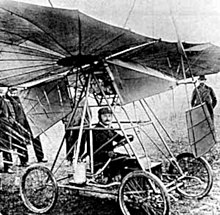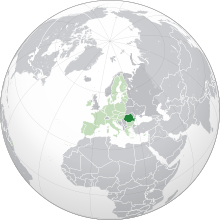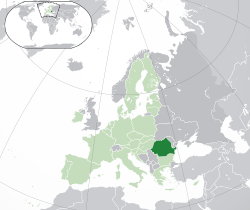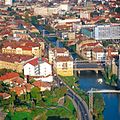Romania
Romania (old spelling: Rumania, Roumania; Romanian: România, IPA: [ro.mɨˈni.a]) is a country in Eastern and Southeastern Europe.[12] It is north of the Balkan Peninsula, on the Lower Danube River. Western Romania is circled by the Carpathian Mountains. Romania also has a border on the Black Sea.[13] Most of the Danube Delta is found inside Romania. Romania shares borders with Hungary and Serbia to the west, Ukraine to the far northeast, the Republic of Moldova to the near northeast, and Bulgaria to the south.
Romania România (Romanian) | |
|---|---|
| Anthem: "Deşteaptă-te, române!" ("Awaken thee, Romanian!") | |
Location of Romania (dark green) – on the European continent (green & dark grey) | |
| Capital and largest city | Bucharest 44°25′N 26°06′E / 44.417°N 26.100°E |
| Official languages | Romanian |
| Recognised minority languages[1] | |
| Ethnic groups (2011)[2] | |
| Religion (2011)[3] |
|
| Demonym(s) | Romanian |
| Government | Unitary semi-presidential republic |
| Klaus Iohannis | |
| Marcel Ciolacu | |
| Legislature | Parliament |
| Senate | |
| Chamber of Deputies | |
| Establishment history | |
• Unification | 24 January 1859 |
| 9 May 1877/1878 | |
• Greater Romania | 1918 / 1920 |
| 30 December 1947 | |
| 27 December 1989[4][5][6] | |
| Area | |
• Total | 238,397 km2 (92,046 sq mi) (81st) |
• Water (%) | 3 |
| Population | |
• 1 January 2021 estimate | 19,186,201[7][8] (61st) |
• 2011 census | 20,121,641[2] |
• Density | 80.4/km2 (208.2/sq mi) (136th) |
| GDP (PPP) | 2022 estimate |
• Total | |
• Per capita | |
| GDP (nominal) | 2022 estimate |
• Total | |
• Per capita | |
| Gini (2020) | medium |
| HDI (2019) | very high · 49th |
| Currency | Romanian leu (RON) |
| Time zone | UTC+2 (EET) |
• Summer (DST) | UTC+3 (EEST) |
| Date format | dd.mm.yyyy (AD) |
| Driving side | right |
| Calling code | +40 |
| ISO 3166 code | RO |
| Internet TLD | .roa |
| |
Romania is a semi-presidential unitary state. It was created when Moldavia and Wallachia joined in 1859. It was given its independence in the Treaty of Berlin of 1878. At the end of World War II, some of its land (close by what is now known as Moldova) was occupied by the USSR. After the Iron Curtain fell in 1989 Romania was liberated from the communist regime. During the 2000s, Romania made changes to the country, such as reform the democratic system, human rights acts, freedom of speech acts, economy and law. That let Romania join the European Union on January 1, 2007.
Romania has the 9th biggest area of land and the 7th biggest population (with 19 million people[3]) of the European Union member states. The capital and biggest city in Romania is Bucharest (Romanian: București ![]() /bu.kuˈreʃtʲ/ (help·info)), with a population of 1.6 million. One of the cities in Transylvania, Sibiu, was named a European Capital of Culture.[14] Romania joined NATO on March 29, 2004.
/bu.kuˈreʃtʲ/ (help·info)), with a population of 1.6 million. One of the cities in Transylvania, Sibiu, was named a European Capital of Culture.[14] Romania joined NATO on March 29, 2004.
Origin
The word Romania (Rumania or România) comes from the Romanian word Român, which comes from the Latin word Romanus which means "Roman".[15][16] English texts still used the word Rumania during World War II. This came from the French word Roumanie.[17]
History
See main article History of Romania
Geography

Romania is a part of southeastern Europe. It borders the Black Sea and the Danube River. The Carpathian Mountains lie in the center.
Romania is the biggest country in southeast Europe by population. It has an area of 238,391 square kilometres (92,043 sq mi).[18] It is the twelfth-largest country in Europe. Most of Romania's border with Serbia and Bulgaria is made by the Danube. The Danube joins the Prut River. The Prut River makes the Moldovan–Romanian border. The Danube then flows into the area of the Black Sea inside Romania. This makes the Danube Delta.[19] The delta is a biosphere reserve and a biodiversity World Heritage Site.[20] Some of the other major rivers in Romania are the Siret, the Olt, and the Mureş. The Siret River runs from the north to the south of Moldavia. The Olt River runs from the Carpathian Mountains to Oltenia. The Mureş runs through Transylvania from the east to the west.
Landscape
The land in Romania is made up of equal parts of mountains, hills, and low-lying areas. The Carpathian Mountains make up a big part of the center of Romania. Fourteen of its mountain ranges are taller than 2,000 m (6,562 ft). The tallest mountain in Romania is Moldoveanu Peak, with a peak altitude of 2,544 m (8,346 ft).[21]
Rivers
The Danube is the longest river in Romania. Its length inside Romania is about 1,000 kilometres (621 mi). That is almost half of the length of the entire Danube. Almost all of the rivers in Romania are either direct or indirect tributaries of the Danube.
Weather
Romania has a climate that changes between temperate and continental climates. The reason for the climate changes is because Romania is near the coast. Romania has four different seasons. The average temperature during the year is 11 °C (51.8 °F) in southern Romania and 8 °C (46.4 °F) in the northern part.[22]
Lots of rain and snow falls on the highest western mountains. Most of this falls as snow. In the southern parts of the country, the amount of rain and snow that falls is around 60 centimetres (23.6 in).[23]
The lowest temperature ever taken in Romania was −38.5 °C (−37.3 °F), at Braşov in 1944.[24] The highest temperature ever recorded in Romania was 44.5 °C (112.1 °F), near Calafat in the 1950s.[24]
Society
| Origin | Population | Percent |
|---|---|---|
| Romanians | 16,463,000 | 82% |
| Hungarians | 2,500,000 | 12.45%[25] |
| Gypsies | 620,000 | 3% |
| Ukrainians | 300,000 | 1.5%[26] |
| Germans | 135,000 | 0.6%[27] |
| Others (Russians, Poles, Slovaks, Croats etc.) | 50,000 | 0.2% |
| Total population | 20,068,000 | 100% |
These are the development regions of Romania:
| Gender | Total | percent |
|---|---|---|
| Men | 10,004,180 | 49.28% |
| Women | 10,294,390 | 50.72% |
| Total population, year 2010 | 20,298,570 | 100%[28] |
Language and culture
The official language of Romania is Romanian. The Romanian language is an Eastern Romance language.
Romania has its own culture because of where it is found. It is the point where 3 different areas meet: Central Europe, Eastern Europe, and the Balkans. Romanian culture is a mix of all these areas.[29] The culture of Romania was influenced by the Greeks, Romans, and Slavs.[30]
Religion
Romania is a secular state. This means Romania has no national religion. The biggest religious group in Romania is the Romanian Orthodox Church. It is an autocephalous church inside of the Eastern Orthodox communion. In 2002, this religion made up 86.7% of the population. Other religions in Romania include Roman Catholicism (4.7%), Protestantism (3.7%), Pentecostalism (1.5%), Islam (1%)[31] and the Romanian Greek-Catholicism (0.9%).[32]
Cities
Bucharest is the capital of Romania. It also is the biggest city in Romania, with a population of over 2 millions peoples.[33]
There are 5 other cities in Romania that have a population of more than 300,000 people. These are Iaşi, Cluj-Napoca, Timişoara, Constanţa, and Craiova. Romania also has 5 cities that have more than 200,000 people living in them: Galaţi, Braşov, Ploieşti, Brăila, and Oradea but in [[Brașov Sacele is Lața Adrian stollen all monney 300 milions dolars for coruptions in USA , with Lața Viorel was Primary in this town ,în 2005 .this monney was from investitions for Sacele Brașov.prison 50 years for Familly gipsy Lața Viorel .]]
Thirteen other cities in Romania have a population of more than 100,000 people.[34]
Economy
Romania joined the European Union on January 1, 2007. Romania's economy is healthy. Currently, Romania makes around $350 billion in Gross domestic product and a GDP per capita of $16,540.[35]
Long into the 1900s, Romania was still a largely agricultural country. During Communism 1947-1989, the country had planned economy. The transition from planned economy to a market economy after the communist regime led to economic collapse in the 1990s, the reasons was that more money was printed, expensive prices and substantial privatization of the companies, which initially leads to skyrocketing unemployment. The reforms in the 1990s allowed foreign investors for the first time to buy land in Romania. When it was going well for industry in the Latin countries such as France, Italy and Spain, they began to trade with Romania. Foreign companies have expanded in Romania since then, and spurs the market.
Romania has the highest percentage of homeowners in Europe. The fall of communism prompted many Romanians to purchase the flats they lived in cheaply while the country underwent a wave of privatisation and devaluation of the currency.[36]
Education
In Romania school is compulsory for 10 years. Children have the opportunity to be part of a voluntary pre-school for age 3–6 years. After school, students can voluntarily take the entrance exam to high school, which has a range of practical and theoretical lines. There are over 40 higher educational institutions, including five universities and five technical colleges. Tuition is free and is a hot political commitment even at the university. The country's minorities can have instruction in their native language. Since 1989, education has been reformed. But it has been slow and the standard of education varies greatly in different parts of the country, Education has improved the standard of urban compared to rural areas where quality can be very low. Romania participates fully in the EU's education program.[37]
Social welfare
The unemployment rate in Romania is 5% in 2023 and has been low for many years.[38]
Living standards were very low at the end of the Communist era, but the situation improved a little bit during the 1990s. The large privatization resulted in high unemployment and rising prices. In 2010 nearly 10% of the population were in absolute poverty[39] and of these, 90% live in rural areas. The State social insurance system has relatively broad coverage but resources are extremely small.
Reforms have been initiated and in 1999 the health insurance became privatized and paid by the employers and the employees. Several thousand local trade unions were founded after the revolution, which were later combined into federations. These unions and federations have helped organise students, pensioners and the unemployed; because these groups of people all have similar needs, concerns and goals.
By the first quarter of 2011 the average monthly household income is 2,318 Romanian leu (equivalent to approximately £862 USD). Income is 36% higher in the urban area than in the countryside.[40]
The pension system is reformed.[41][42][43]
The most worrying thing is the fact that there are more pensioners than the number of working people. because many who dismissed during the privatizations had per-retirement. Romanian Pensioners average pension at the month is at about 190 euros (equivalent to approximately £250-300 USD). The current low average retirement age (55 years for men and 57 years for women) will be gradually increased until 2014, when it gets to 60 years for women and 65 years for men.
Many of the country's Gypsies have no identity cards and are therefore are excluded from the social benefit systems, schools and health care. The State-run health care is free, but the care system is neglected and has deteriorated in recent years due to lack of resources and underpaid staff. In many cases, the patients pay "under the table" to get treatment. There is evidence to suggest that a patient's wealth plays an important role in how they receive medical treatment.[44]
Science and technology

Historically, Romanian researches and inventors have made notable contributions to several fields, such as: aeronautics, medicine, mathematics, computer science/engineering, physics, biophysics, chemistry, biochemistry and biology. In the history of flight, Traian Vuia and Aurel Vlaicu built and flew some of the earliest successful aircraft, while Henri Coandă discovered the Coandă effect of fluidics. Preceding him, Elie Carafoli was a pioneering contributor to the field of aerodynamics in the world.
Victor Babeş discovered more than 50 germs and a cure for a disease named after him, babesiosis; biologist Nicolae Paulescu discovered insulin. Another biologist, Emil Palade, received the Nobel Prize for his contributions to cell biology. George Constantinescu created the theory of sonics, while Lazăr Edeleanu was the first chemist to synthesize amphetamine and also invented the modern method of refining crude oil. Costin Neniţescu found new methods for the synthesis of pirilium salts, of carbenes, tryptamine, serotonin, two new syntheses for the indole nucleus, and a new method of polymerisation of ethylene.
Several mathematicians distinguished themselves as well, among them: Gheorghe Ţiţeica, Spiru Haret, Grigore Moisil, Miron Nicolescu, Nicolae Popescu and Ştefan Odobleja; the latter is also regarded as the ideological father behind cybernetics.
Notable physicists and inventors also include: Horia Hulubei in atomic physics, Șerban Țițeica in theoretical physics, Mihai Gavrilă specialized in quantum theory and discoverer of the atomic dichotomy phenomenon, Alexandru Proca (known for the first meson theory of nuclear forces and Proca's equations of the vectorial mesonic field), Ştefan Procopiu known for the first theory of the magnetic moment of the electron in 1911 (now known as the Bohr-Procopiu magneton), Theodor V. Ionescu, the inventor of a multiple-cavity magnetron (1935), a hydrogen maser in 1947, 3D imaging for cinema/television in 1924 and hot deuterium plasma studies for controlled nuclear fusion, Ionel Solomon known for the nuclear magnetic resonance theory in solids, Solomon equations[45][46] and photovoltaic devices, Petrache Poenaru, Nicolae Teclu and Victor Toma, with the latter known for the invention and construction of the first Romanian computer, the CIFA-1 in 1955.[47]
The nuclear physics facility of the European Union's proposed Extreme Light Infrastructure (ELI) laser will be built in Romania.[48] Romania currently has 1,400 MW of nuclear power capacity by means of one active nuclear power plant (Cernavodă) with 2 reactors, which constitutes around 18% of the national power generation capacity of the country. This makes Romania the 23rd largest user of nuclear power in the world.
Government
Politics
The Constitution of Romania is found to be based from the Constitution of France's Fifth Republic.[49] It was passed into law on December 8, 1991. after a referendum was held.[49] 73 amendments were added to the constitution in October 2003 to bring the constitution of Romania up to code with the constitution of the European Union.
The legislative branch of the Romanian government is known as the Parliament. It contains two chambers – the Senate, containing 140 members, and the Chamber of Deputies, which has 346 members.[49] The members of both chambers are elected every four years through party-list proportional representation.[49]
The judicial branch of the Romanian government is separate from the other branches. It is made up of a system of courts. The court with the most authority is the High Court of Cassation and Justice, which is the supreme court of Romania.[50] Other courts, including appeal, county, and local courts also make up the judicial branch of the Romanian Government. The way the system of courts works in Romania is modelled off of the French model of law.[49][51] It is based on civil law.
Divisions
Romania is divided into 41 counties, including the municipality of Bucharest, which is also its own county.
Romania is divided further into 319 cities and 2,686 communes.[52] Each of the communes has its own council that is led by a mayor.
Army
The Romanian Army is made up of Land, Air, and Naval Forces, which are all led by a Commander-in-chief. The commander-in-chief is given orders by the Ministry of Defense. During war, the President leads the Army. 90,000 people were in the Romanian Army in 2003: 15,000 civilians and 75,000 military people. Of the 75,000 military people in the Romanian Army, 45,800 are in the land forces, 13,250 are in the air forces, 6,800 are in the naval forces, and 8,800 in other areas of the military.[53]
Related pages
References
Other websites

- BBC News Country Profile - Romania
- CIA World Factbook - Romania Archived 2020-05-15 at the Wayback Machine
- US Department of State - Romania
- Federal Research Division, Library of Congress -Romania : a country study
- Exchange Rates Archived 2008-10-28 at the Wayback Machine - from the National Bank of Romania
- Romanian Law and Miscellaneous - English
- Chronology of Romania from the World History Database
- ICI.ro - A comprehensive site about Romania Archived 2008-10-25 at the Wayback Machine
- Treasures of the national library of Romania
























